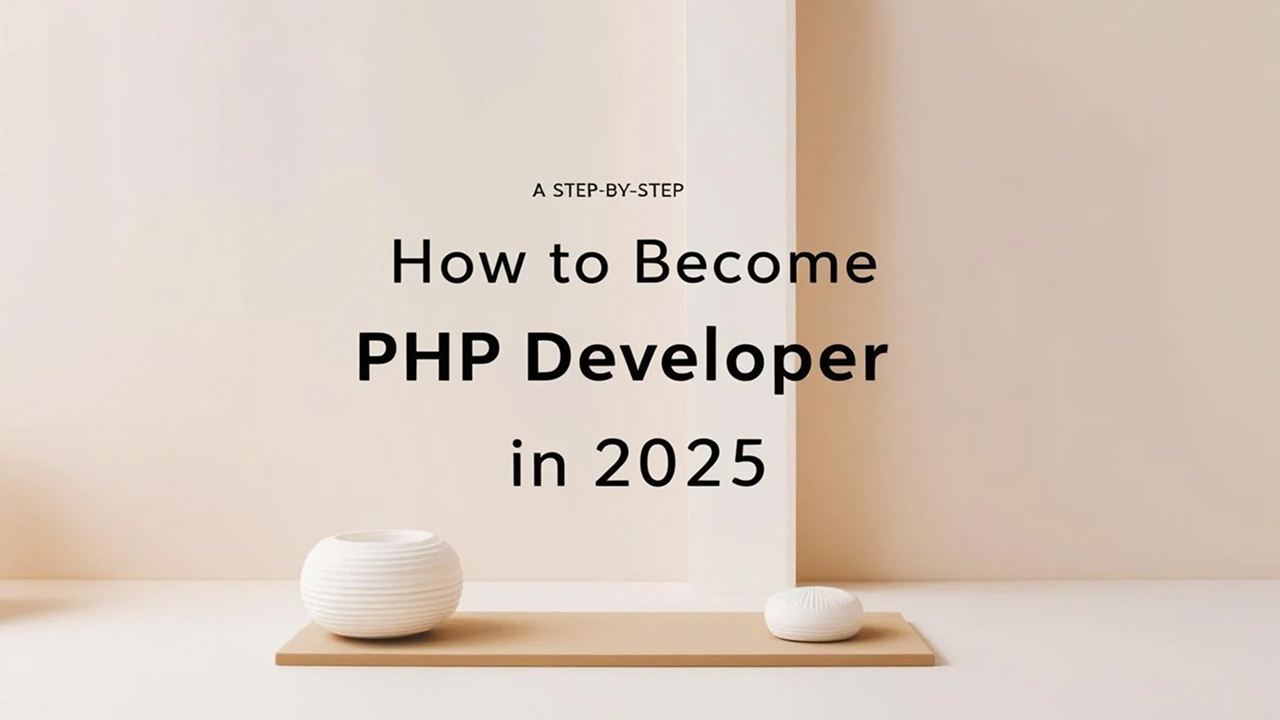PHP remains a cornerstone of web development, powering over 75% of websites, including giants like WordPress and Laravel-based platforms. Becoming a PHP developer in 2025 offers a stable, rewarding career path with opportunities in backend development, CMS customization, and modern frameworks. This guide outlines the steps to master PHP, build a portfolio, and land your first job.
Step 1: Understand the Role and Market Demand
PHP developers build server-side logic, APIs, and dynamic web applications. In 2025, demand persists for PHP expertise, especially in:
- WordPress development: Custom themes and plugins.
- Laravel and Symfony: Enterprise-grade applications.
- E-commerce: Platforms like Magento and WooCommerce.
Action: Research job postings on platforms like LinkedIn or Indeed to identify required skills (e.g., PHP 8, MySQL, REST APIs).
Step 2: Master Core PHP
Start with the fundamentals of PHP 8.x, the latest version in 2025, which emphasizes performance and type safety.
Key Topics to Learn:
- Syntax and Variables: Understand loops, arrays, and functions.
- OOP in PHP: Classes, inheritance, and interfaces.
- Error Handling: Try-catch blocks and custom exceptions.
- PHP Standards (PSR): Follow PSR-12 for clean code.
Resources:
- PHP Manual (free, official documentation).
- Interactive platforms like Codecademy or freeCodeCamp.
- Books: PHP 8 Objects, Patterns, and Practice by Matt Zandstra.
Action: Write simple scripts (e.g., a calculator or form processor) and host them on a local server using XAMPP or Docker.
Step 3: Learn Frameworks and Tools
Frameworks streamline development and are mandatory for most PHP jobs. Focus on:
Top Frameworks:
- Laravel: Known for elegant syntax and robust features like Eloquent ORM.
- Symfony: Ideal for complex, scalable applications.
- CodeIgniter: Lightweight, beginner-friendly.
Essential Tools:
- Composer: Dependency management.
- PHPUnit: For unit testing.
- Git: Version control (use GitHub for collaboration).
Resources:
- Laravel’s official Laracasts ($15/month, beginner-friendly).
- Symfony’s documentation (free).
- Build a small CRUD app (e.g., a to-do list) with Laravel.
Action: Deploy your app to a cloud platform like Heroku or DigitalOcean for public access.
Step 4: Master Databases and APIs
PHP developers often work with databases and APIs to create dynamic applications.
Database Skills:
- MySQL/MariaDB: Learn queries, joins, and indexing.
- ORMs: Use Laravel’s Eloquent or Doctrine for efficient database interaction.
- NoSQL: Familiarize yourself with MongoDB for flexibility.
API Development:
- RESTful APIs: Build endpoints for CRUD operations.
- GraphQL: Explore for advanced API needs.
- Authentication: Implement OAuth or JWT.
Resources:
- MySQL Crash Course on Udemy (~$20).
- Free tutorials on YouTube (e.g., Traversy Media’s PHP + MySQL series).
- Practice by building an API for a blog system.
Action: Create a database-driven app (e.g., a blog with user authentication) and expose its data via a REST API.
Step 5: Build a Portfolio
A strong portfolio showcases your skills to employers. Include:
- 3-5 Projects: A WordPress plugin, a Laravel e-commerce site, or a Symfony dashboard.
- GitHub Repository: Clean, documented code.
- Live Demos: Host projects on free platforms like Render or Vercel.
- Blog Posts: Write about your projects (e.g., “How I Built a Laravel API”).
Action: Create a personal website using PHP to display your projects. Use a simple framework like Slim for lightweight routing.
Step 6: Gain Practical Experience
Real-world experience sets you apart.
Options:
- Freelancing: Find gigs on Upwork or Fiverr (e.g., WordPress customization).
- Open Source: Contribute to PHP projects on GitHub (e.g., WordPress core or Laravel packages).
- Internships: Apply to local startups or agencies.
Action: Complete at least one freelance project or open-source contribution. Document your process for your portfolio.
Step 7: Learn Modern DevOps and Deployment
Employers value developers who understand deployment workflows.
Key Skills:
- Docker: Containerize PHP applications.
- CI/CD: Set up pipelines with GitHub Actions.
- Cloud Platforms: AWS, Google Cloud, or Azure basics.
- Nginx/Apache: Configure web servers.
Resources:
- Free Docker tutorials on YouTube (e.g., TechWorld with Nana).
- AWS’s free tier for hands-on cloud practice.
Action: Deploy a PHP app using Docker and GitHub Actions to a cloud provider.
Step 8: Network and Apply for Jobs
Networking and visibility are critical for landing a job.
Strategies:
- LinkedIn: Share PHP tips and connect with recruiters.
- Meetups: Attend local or virtual PHP conferences (e.g., PHP[world]).
- Certifications: Consider Zend Certified PHP Engineer ($195, globally recognized).
- Job Boards: Apply via Indeed, Glassdoor, or We Work Remotely.
Action: Tailor your resume to highlight PHP projects and frameworks. Write cover letters emphasizing your problem-solving skills.
Step 9: Stay Updated
PHP evolves rapidly. In 2025, expect:
- PHP 8.3/8.4: New features like readonly properties.
- AI Integration: PHP for backend AI APIs (e.g., integrating with xAI’s Grok).
- Performance Optimization: JIT compiler mastery.
Resources:
- Follow PHP Weekly newsletter.
- Join X communities like #PHPDev for real-time updates.
Action: Subscribe to PHP-related blogs and experiment with new PHP features in side projects.
Final Tips
- Timeframe: Expect 6-12 months to go from beginner to job-ready, depending on prior coding experience.
- Practice Daily: Code for 1-2 hours daily using platforms like LeetCode for problem-solving.
- Soft Skills: Communication and teamwork are as vital as coding.
Becoming a PHP developer in 2025 is achievable with dedication and a structured approach. Start coding, build projects, and showcase your skills. The web needs you!
Want to dive deeper? Check out my GitHub for PHP projects or connect with me on LinkedIn for tips!
